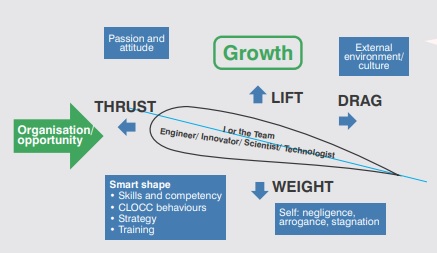Career Lift kara de

The human mind has the power to analyse, explore and decode many hidden secrets/treasures of nature. Historically, mathematicians have been amused by geometric shapes like circles, ellipses, cylinders, spheres, cones, etc. and the scientific community learned to use them in industrial products. Engineering equipment like vessels, tankers, tubes, reactors, piping etc. – all follow particular geometric shapes.
Mathematician Max Munk discovered a shape that opened infinite possibilities to lift the machines heavier than air and forever changed the way people travel.
This shape called ‘airfoil’ can generate more lift with significantly less drag. The major forces acting on airfoil are thrust, gravity (weight), drag and lift. For an aircraft, thrust is provided by the engine, and the airfoil shape provides the required lift to reach the sky by balancing the drag and gravity acting on the aircraft.
Modifying the airfoil shape resulted in a boon for the aircraft industry in the 20th century. During an air journey, the most magical moment is the first lift achieved by thrusting the aircraft on the runway and pushing against the gravity pulling it down. Here, the role of the airfoil is to provide the required first lift. The thrusting aircraft without an airfoil shape, probably will just remain as a massive vehicle on the wheels. To transform it into an aircraft, the shape of the airfoil has a significant role.
Similarly, the theory of the ‘aircraft lift’ can be applied in our life to achieve our career aspirations. If we observe the professional trajectory of some successful individuals who have been able to reach the top of their organisations in a short time frame, we can see their drive to excel. The same holds true for today’s startups that strive hard to convert the proof of concept into a ‘unicorn’.
How are some able to make that mark by lifting their professional career trajectory? Let us again examine the forces acting on the airfoil.

We will use an analogy like ‘thrust’ and ‘lift’ to represent positive forces necessary for professional growth, and ‘drag’ and ‘gravity’ would represent negative forces opposing growth.
Thrust in an aircraft is provided by the engine. As for professional growth, the person is the engine, while the fuel is his/her passion and attitude. To achieve higher professional goals, you should have great passion, vision and a positive attitude (high calorific value).
As explained by Sadhguru, an eminent yoga guru and spiritual leader, the human mind is a combination of four major parts – buddhi (intellect), manas (memory), ahamkara and chitta (mind without memory – pure intelligence). Ahamkara is not ego but the identity of a person’s personality.
Buddhi is the intellect that helps ahamkara to take a proper shape by supporting it. Hence, one should use this ahamkara very positively and constructively. In Indian philosophy, this ahamkara is developed by saying aham brahmasmi which means I am the cosmos. When you train your mind in this way, you break the boundaries and become limitless or infinite just like the cosmos. Buddhi and manas (fuel) help you to achieve that path of infinity.
‘Drag’ is the negative force which actually drags you backwards from your professional career path. It is created by the external environment and sometimes by forces that are beyond your scope. We should be aware of it and should make efforts to reduce its impact.
The weight/gravity concept is psychological in this reference. During the course of a person’s professional journey, a lot of ‘weight’ of arrogance, biases, judgements, and beliefs accumulate, which can lead to stagnation. These added weights try to pull you down, and it becomes very difficult to achieve the desired lift.
The airfoil’s smart shape helps to generate lift. Let’s try to connect this with our professional life. Fundamentally, it is the core quality of a professional to get that required lift. It is an outcome of a person’s effort to shape his/her career. This is reflected in the way the person approaches problems. Hence, the airfoil approach becomes the core quality of a person.
In Thermax, this attribute is defined under the CLOCC behaviours — Customer centricity, Lead, Own, Create and Collaborate. Along with an excellent performance spirit, the person should be able to exhibit the above valuable behaviours as well.
Michelangelo was a famous sculptor and painter in the 15th and 16th centuries who got the opportunity to work as a sculptor in St. Peter’s Basilica, Vatican City. He started his work when Leonardo da Vinci had immense influence, but he could make his mark in history by creating masterpieces like Pieta and the painting of the Sistine Chapel ceiling. After creating Pieta (Virgin Mary holding her dead son) at a very young age, people asked him how he could create such a beautiful sculpture. He replied, “I saw the angel in the marble and carved until I set him free.” He only removed the unwanted parts from it. It’s indeed a great inspiring thought. Similarly, the ‘smart shape of the airfoil’ resides within each one of us, and we just need to remove that extra unwanted part.
When the engine (you) is fired by fuel (passion), you have got the smart airfoil shape (attitude), and if the engine remains fit (positive attitude), then even if the weather is turbulent (obstacles), what is guaranteed is the ‘lift’ (growth path). Grab the opportunity by keeping your wings firm to propel with that lift and keep thrusting to new heights.
In the end, when you realise that you are about to exhaust your fuel (retirement), thank the people who supported you, the organisation for the rewarding opportunity, appreciate yourself for the value you created in this journey and finally take a nose dive (‘natmastak’) in gratitude to land safely.
Be proud of the wonderful journey called ‘flight’.
Dr. Devkumar Gupta
RTIC



